Lenses
XF
18-55mm F2.8-4 R OIS LM
Most of our shots with the X-E1 were done
with the 18-55mm ‘kit’ lens (27-80mm equivalent), which supplements a
noticeable weight to the camera, weighs 310 grams - just 40 grams lighter than
the camera body with the battery and memory card installed. The 18-55mm lens
comes without the typical exaggerated zoom at about $700 when purchased
separately, it is not a cheap lens, and with a maximum aperture of F2.8-4, at least
it is a quicker stop than the normal kit zooms, which partially explains its
structure of corresponding weight. Despite the relatively large maximum
aperture, the lens is not much larger than the 60mm F2.4 R Macro of Fujifilm or
E 18-55mm F3.5-5.6 OSS of Sony for NEX.
Fortunately, the cost and the weight are
adjusted by the excellent optical quality, appealing bokeh and smooth
operation. Specifically zooming is very smooth, but the FBW system, the
aperture ring that is not marked alters so easily. We’d prefer the solid
detents to avoid accidental operation.

18-55mm
@ 18mm (27mm equivalent)

18-55mm
@ 55mm (80mm equivalent)
The 'LM' designation shows that the 18-55mm
uses a Linear Motor focusing system, with two motor controlling the focus group
that is generally wider than usual; This, and internal focusing system, which
is designed to get faster autofocus; that is nearly silent while filming.
Fujifilm announces that the optical image stabilization allows the hand-held
shutter speeds four stops slower than would conversely be feasible without
image blur caused by camera shake.
Overall, this is firmly maintained during
our use, and assuming a static object, we were able to take reliably sharp
photos at shutter speeds between 1/15 - 1/10 second in the length of 18-55mm
zooms; and accepted sharpness drops down to 1/8-1/5 second; although not, at
this point, with 100% reliability.
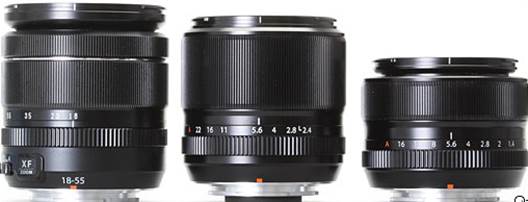
To
compare (left to right): XR 18-55mm F2.8-4 R OIS LM beside the XF 60mm F2.4 R
Macro, and the XF 35mm F1.4 R.
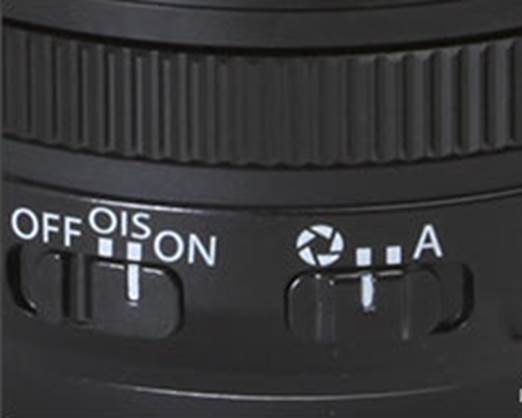
Because
the 18-55mm F2.8-4 has a diversified maximum aperture, its aperture is not
marked – instead - instead it revolves continuously, with clatters for every
three times to change the stop.
A separate switch on the side chooses
between aperture control on the lens or automatically control by the camera
when set at the A position.
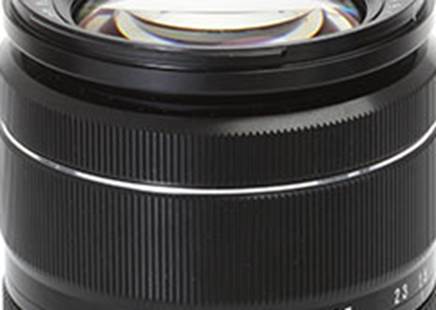
The
zoom and focus rings of the 18-55mm zoom are separated by a thin metal ring, in
addition to a beautiful picture approach to design. Both operate very smoothly.
The 18-55mm can of course also be possible
to use on the X-Pro1, and when shooting with the optical viewfinder, the frame
border will be magnified to fit the current focal length.
Bokeh
The X-E1 equipped with a diversified
aperture zoom lens limits the ability to control the background blur in the
specific focal lengths when compared with quicker fixed aperture lens, but the
XF18-55mm F2. 8-4 lens still manifests fine out-of-focus characteristics, and
pleasant bokeh.
The table below shows the 18-55mm compared
to the excellent (non-zooming) 35mm prime, at the same focal length. Of course,
the kit lens zoom is up to 35mm, as presented below, which limits its maximum
available aperture - F3.6 compared to F1.4 from the prime. But the quality of
the out-of-focus backgrounds from both lenses at the same aperture is very high
– the 18 -55mm offers slightly more complicated bokeh than the prime at the
same aperture settings, but only very little.
We also include a photo showing the 35mm
prime that has no zoom of "wide aperture" at f1.4, to prove shallower
depth that might give photographs from the faster lens.

18-55mm
kit @ 35mm, F3.6 - 35mm F1.4 @ F3.6 - 35mm F1.4 @ F1.4
Using
third-party lenses with adapters
One of the big advantages of mirror less
cameras is the ability to use a variety of lenses via mount adapters; including
top-quality focal Leica M-mount primes and the great number of 'orphaned'
manual focus lenses from the outdated film camera systems. Fujifilm creates a
very intelligent adapter for Leica M-mount lenses, and third-party adapters are
ready for the plethora of mounts for both the current and older systems.
It is likely to find adapters on eBay for
electronic lens mounts like Canon EF, but these lenses do not really work
effectively on the X-E1 since there are no powerful functions available -
including aperture setting and image stabilization.
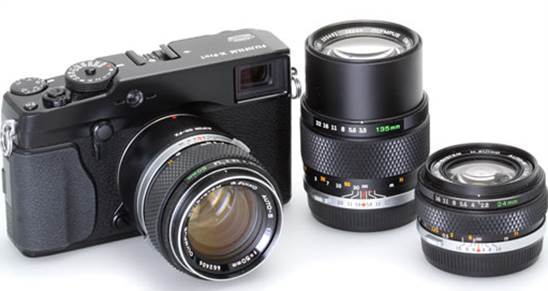
The
X-Pro1 (X-E1 compatibility is identical) with three Olympus OM Zuiko lenses
from the 1970s that are still easy to find all, from right to left, 50mm F1.4,
135mm F3.5 and 24mm F2 .8
The use of adapters has greatly expanded
many scopes of lenses that can be used with the Fujifilm X-E1 beyond the three
initial natural proposals, especially for photographers who already have a
collection of old autofocus lenses covered by full of dust in the closet. To
use them, first, you have to enable Mount Adapter Settings in the menu. Of
course, the adapted lenses do not provide automatic functions, so both of the
focus and aperture must be set manually. It should go without saying that it is
better to focus the lens wide open, and then lower the desired aperture.
When using the Leica M-mount adapter of
Fujifilm, it automatically switches off the current-spare distance scale in the
viewfinder, and enables optical error correction configuration that users set
to store up to six lenses (covering distortion, color shading and shadow vignette).
These functions are not available with third-party adapters.
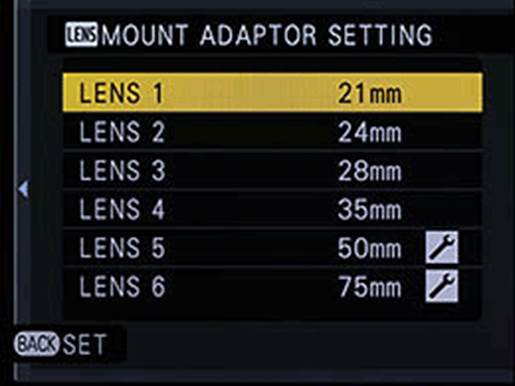
The
X-E1 has a menu option to set the focal length of the lens you are using. This
used to be filled in the EXIF data. The camera offers four presets
corresponding to the most popular film wide angles - 21mm, 24mm, 28mm and 35mm
and two more distant lens memories, which can be set freely (with 50mm and 75mm
available by default)
It should be noted that although the X-E1
does not provide any manual focus support other than magnified view in the EVF,
and the most notable thing is that there is no "Focus Peaking"
display. In general, though, we think the X-E1 would seem to be the better
cameras for adapted lenses thanks to the better deployment of the electronic
viewfinder.
The Fujifilm M-mount adapter
The M-mount adapter of Fujifilm is unique
in having electronic contacts that inform the camera when it is attacked. It
has two buttons on its rim, a lens release, while the other brings the 'Mount
Adapter Settings' to the screen of the camera. However, these contacts limit
the diameter of the hole in the rear of the adapter, meaning that the lenses
with large rear sections will not match it.
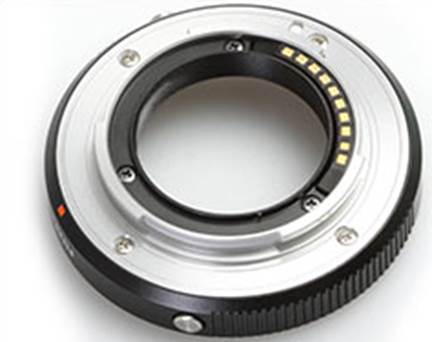
This
is Fujifilm’s adapter which allows use of Leica M-mount lenses on the X-E1 and
the X-Pro1. The simply third-party versions have no electronic contacts, and
therefore do not provide error correction options for lens.
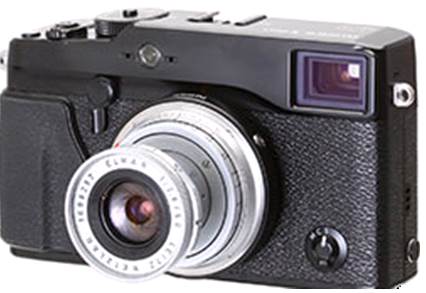
This
is the X-Pro1 with an old folded Leica Elmar 50mm 1:2.8. Here you also clearly
see the button that brings up the adapter settings menu.
The adapter consists of a plastic measure
with two functions that you can see by clicking through on the image above.
This allows you to check not only that the lens is not pressed too deeply into
the body, but also that the diameter of the rear does not touch with the
contacts (which is not a problem with an simpler third party adapter unit).
The known incompatibilities include 21mm
ultra-wide angles and fast 35mm fixed lenses. However, the single lens error
correction menu is only available with the Fujifilm adapter, so it is almost
impossible to establish error corrections for these lenses, even if you can put
them on the mount.